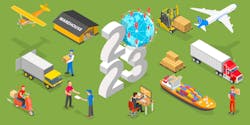How were your holidays? How is your supply chain?
We’re emerging from two stressful periods—the holidays and a supply-chain crisis. As such, this is a good time to conduct a pulse-check on manufacturing logistics, so we connected with Hans Thalbauer, managing director for supply chain and logistics at Google Cloud, for insights on the strategies businesses are leveraging to make their supply chain resilient and nimble at the start of (and throughout) this new year.
Take a look…
Smart Industry: How do busy periods (such as the holidays) affect manufacturers' supply chains?
Hans: Busy periods like the holidays push manufacturers’ supply chains to maximum capacity, making them susceptible to issues that can arise as a result of any demand variation. Pre-pandemic, it was easier to predict and prepare for influxes around busy seasons, but uncertain economic conditions, shifts in consumer behavior, and material shortages over the past two years have created huge challenges in forecasting. Potential issues include staffing and quality control, upstream supplier disruptions, and transportation availability/delays. All of these things are directly tied to manufacturers' ability to deliver products on time.
Smart Industry: As we emerge from the worst of the supply chain crisis, what new strategies are emerging to make supply chains more resilient?
Hans: The past two years taught us to expect the unexpected. To address this level of unpredictability, we are seeing businesses investing in new technologies—such as artificial intelligence and data analysis—to help create more visibility and efficiency within their business.
With these new technologies, businesses can look at a multitude of scenarios to prepare and solve for a problem before it even occurs. At Google Cloud, we’ve seen an uptick in interest for these types of solutions, which enable customers to build a digital representation of their supply chain, providing them with a holistic look at every aspect of their supply chain by managing stock, improving forecasting, and optimizing fulfillment.
In addition to the need for technology, companies are also redefining their supply chain to take a more regional approach, keeping things closer together in order to increase control, reduce risk, and reach sustainability goals.
Smart Industry: What makes a nimble supply chain? Why is this beneficial?
Hans: A nimble supply chain is one that can respond quickly and effectively to changes as they arise, enabling them to be more resilient to challenges like natural disasters or sudden changes in market conditions. For example, this can be incredibly important when looking to purchase inventory for a business. Say you own a restaurant and you typically purchase your corn from one supplier, but they inform you that the weather greatly impacted their crops and they won’t be able to fulfill your produce order. Do you have other farms that you have a relationship with? Are you able to pivot and increase your orders elsewhere so that you can still keep your restaurant running? That is where AI can come in to help with problem solving. It looks at weather patterns affecting your partners and suppliers and predicts that shortage before it happens, enabling you to change your orders before it’s too late.
Smart Industry: What is the role of data analytics / AI in modern, smart supply-chain strategies?
Hans: Data analytics and AI can help businesses gain insights into their operations, identify inefficiencies and areas of improvement, and make data-driven decisions that can optimize business outcomes. As mentioned, data analytics and AI can be used to forecast demand disruptions for products and services before they occur. Additionally, there are solutions that empower businesses to optimize across every stage of the last-mile delivery journey: capturing valid addresses, optimizing delivery routes, efficiently navigating drivers, tracking shipment progress, and analyzing fleet performance.
Smart Industry: The start of the year is a time for optimism. What do you find most encouraging about the near future of supply-chain management?
Hans: In the near future we will see demand and supply getting closer to an equilibrium. However, disruptions are here to stay and the need for a more sustainable supply chain will accelerate. Therefore the transition from an ERP-centric supply chain to a data-driven supply chain will be key to enable companies to gain needed visibility, flexibility and innovation.
